Minnesota, just like several other US states, has many turtle species. Some of these species are also common in other states, although the characteristics may differ slightly due to the different geographical factors. The aquatic species inhabit forests, lakes, rivers, ponds, and other water bodies in Minnesota. There are also semi-aquatic species that are commonly found in well-vegetated habitats which are close to water bodies.
So, how many turtle species are there in Minnesota?
There are 11 turtle species in Minnesota. Below is a comprehensive list of all the native turtles in this state:
- Blanding’s Turtle
- Common Snapping
- False Map
- Common Map
- Eastern Spiny Softshell
- Ouachita Map Turtle
- Wood Turtle
- Western Painted Turtle
- Midland Smooth Softshell
- Western Spiny Softshell
- Eastern musk turtle
This article will help explain the characteristics of each of these turtles, their appearance, diet, reproduction behavior, and conservation status. It will also touch on whether it is possible to have one as a pet and the laws regarding turtle pets. Now, let us consider each of the above turtles.
1. Blanding’s Turtle

The scientific name for this turtle is Emydoidea blandingii. Blanding’s turtle assumes a more dome-shaped appearance than most other turtle species. The carapace is brown or black, while its plastron is yellow with multiple black patterns. Their skin is usually dark brown, black, or sometimes yellow. The lower part of a Blanding turtle’s neck has a consistent yellow color.
Blanding’s turtles are medium-sized turtle species measuring between 7 and 10 inches. They are known to have a lifespan of between 60 and 80 years. Being aquatic, they are commonly found in clean and shallow water bodies with soft bottoms, either composed of mud or sandy soils. These may include creeks, marshes, small lakes, slow-moving rivers, and ponds.
Blanding’s turtles are omnivorous, and their diet is usually composed of small fish, invertebrates, aquatic vegetation, snails, and other small aquatic animals. They may sometimes come out of the water to graze on the terrestrial vegetation, although this is not very common.
Reproduction occurs from late March through September when the hatchlings hatch. It will take a female, on average, about 18 years for them to achieve sexual maturity. Males mature a bit earlier by the 12th year. Females will start laying eggs between the last week of June through July. A Blanding’s female turtle lays only one clutch per year. The clutch has between 3-19 eggs, but on average, about ten eggs. Incubation takes between 80 to 120 days.
Blanding’s turtles are considered one of the endangered turtle species in Minnesota due to predation and habitat destruction. For those interested in having these turtles as their pets, a juvenile Blanding’s turtle will cost on average about $300. You will also require previous turtle handling experience to take care of a Blanding’s turtle.
2. Common Snapping Turtle
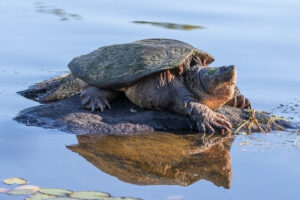
Chelydra serpentina, is the scientific name of this turtle species thatrange in color from dark brown to black. These turtles have long limbs and tails. One of their most distinctive features is their pronounced beak-like mouth. They have strong jaws that can easily crush their prey. These turtles have a rough carapace with keels, and the plastron is smaller than the upper shell. Their skin, limbs, and tails are brown.
Common snapping turtles measure between 8 and 18.5 inches, with the females being bigger than the males.
These turtles are omnivores with a wide range of diets, including fish, insects, mollusks, crustaceans, amphibians, birds, aquatic vegetation, carrions, algae, and other invertebrates.
Common snapping turtles are aquatic turtles commonly found in freshwater bodies with soft bottoms and dense vegetation. They are common in slow-moving rivers, ponds, wet meadows, marshes, and lakes. These snapping turtle species have a lifespan of between 30 and 50 years. The hatchlings are the most vulnerable to predators.
Breeding season in snapping turtles occurs between May and September. A female lays only one clutch in a year with between 20 and 40 eggs. Incubation takes about 90-100 days. The main predator during this stage is the raccoon which will feed on both the eggs and the hatchlings.
Female snapping turtles take about 15 years before they start laying eggs.
Common snapping turtles can be aggressive, and their bites can cause serious harm. For this reason, a pet owner must have some skills in handling these turtles. Pet common snapping turtles cost between 30 and 50 dollars. They are not considered endangered, but habitat destruction has caused a decline in their numbers.
3. False Map Turtle
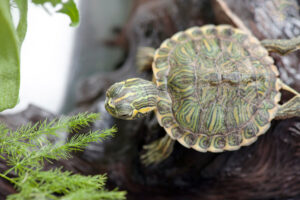
False map turtles, Graptemys pseudogeographica, have are olive or brown or sometimes black with some dark patches with thin yellow lines surrounding them. The shells of some turtles have web-like patterns. The lines on their shells form some sort of map but are different from those in map turtles hence the name false map turtles.
The lower side of the turtles is yellow, while the skin, head, neck, and limbs all have a dark color with multiple thin, yellow or white stripes. Males average a length of between 3 and 5 inches while females are slightly bigger, averaging between 8 and 10 inches.
The lifespan of these turtles is between 30 and 50 years.
Their habitat is mainly stagnant or slow water bodies that are densely vegetated. They commonly inhabit lakes, streams, ponds, and rivers. These turtles are known to bask from time to time. Being omnivores, false map turtles primarily feed on insects, aquatic vegetation, algae, invertebrates, mollusks, and small marine animals.
Reproduction in false map turtles happens twice a year, in April and October. The first nesting season runs from mid-May through July, while the other occurs from late October. Females will lay between 2-3 clutches every year, each with an average of 8-22 eggs. Incubation lasts between 70 and 80 days. Females map turtles take between 8 and 14 years to reach sexual maturity, while males take 4 to 6 years.
A false map turtle does not require specialized care, and a pet owner with little to no skills can take care of one. The price of a false map turtle pet is between $10 to $50. In terms of their conservation status, they are not considered as endangered.
4. Common Map Turtle

The scientific name for this map turtle species is Graptemys geographica. They are named after the map-like patterns that are common on their carapace. The carapace has keels, and in most turtles, it is rough towards the back. It is olive green in color.
The plastron of common map turtles is cream with dark lines marking the scutes. These lines, however, disappear as the turtle ages. The head and limbs of a map turtle have intricate yellow striped patterns that complement the plain olive green color. A notable characteristic is a bright yellow, at times orange mark behind each turtle’s eye.
A female mature map turtle has a length of about 11 inches, while males average only about 5 inches. Being aquatic, these turtles are common in shallow, slow-moving water bodies with soft mud or sand at the bottom. They are also common in areas with open clearings and rocks for basking in the sun.
Common map turtles are omnivores but rely heavily on meat as opposed to vegetation. Their diet consists of tiny marine animals, insects, invertebrates, and mollusks, but they occasionally feed on foliage. The lifespan of common map turtles is between 40 and 50 years.
Breeding in map turtles happens between May and September. A female map turtle lays between 10-12 eggs in a clutch and may lay up to 2 clutches each year. Incubation in map turtles takes between 70 and 90 days. Sexual maturity is achieved by the 6th year in males, while females may take up to 10 years.
A pet turtle does not need much care and is suitable for even beginners with no skills. A pet costs between $30 and $50. In terms of conservation, they are not considered endangered.
5. Eastern Spiny Softshell
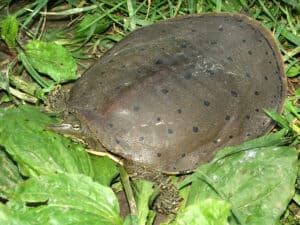
As the name suggests, an Eastern spiny softshell is one of the soft-shelled aquatic turtles. Its scientific name is Apalone spinifera. They are endemic to the Central and Southern counties of the state of Minnesota. A distinctive feature of the spiny softshell is its large flattened and rubbery shell. Their carapaces are soft, olive green, and are covered with some dark spots.
Eastern spiny softshell turtles have a long pointed beak-like mouth. They use this to breathe when they are buried under mud while waiting for their prey. The underside of these turtles is yellow with some dark spots. The upper side of its skin, head, and limbs has an olive green color, similar to the shell but without the Dark spots.
Spiny softshell turtles are aquatic, which means that they spend most of their lives in the water. They are common in faster-moving water bodies with sandy bottoms and are among the fastest swimming turtles. These turtles are carnivorous and feed on small marine animals like fish, mollusks, insects, and crustaceans. As mentioned above, they hunt by hiding under the sand and ambushing their prey.
Females spiny softshell turtles grow bigger than males. A mature female turtle will achieve a size of between 12 and 20 inches, while the males may reach between 5 and 9 inches. They have a lifespan of between 30 and 70 years.
Breeding occurs between May and July. A female will lay between 4 and 38 eggs in a clutch. Incubation in spiny softshell turtles takes between 60 to 80 days, while sexual maturity takes about ten years in females, while in males, about six years.
According to the state laws of Minnesota regarding turtles, one may collect a spiny softshell turtle from the wild but will need a turtle license for this. Also, one may import wild turtles from other states. You might need to, however, prove that the turtles were legally obtained in those states. An Eastern spiny softshell turtle pet goes for between $80 and $150. You require previous turtle handling skills to take care of this pet.
6. Ouachita Map Turtle
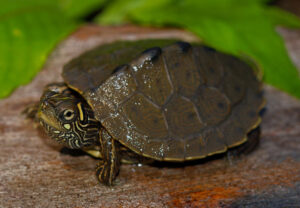
Graptemys ouachitensis ouachitensis, as it is known scientifically is an aquatic turtle of the map turtle species. The name is a result of the map-like pattern on the upper shell. The shell also has a prominent vertebral keel. The map-like marks and the keel, however, disappear as the turtle ages. The skin of these has a dark color with thin yellow-white stripes.
Ouachita map turtles spend most of their lives in water, inhabiting stagnant or slow-moving water bodies that are densely vegetated. They are common in rivers, lakes, ponds, and slow-moving streams. These turtles are omnivorous whose diet includes fruits, vegetation, seeds, insects, algae, mollusks, and other small marine animals.
Just like with most turtles, females are bigger than males. A mature Ouachita female turtle will measure between 8 and 10 inches, while a male turtle will measure between 3 and 5 inches. The lifespan of this turtle is between 30 and 50 years.
Breeding in Ouachita map turtles happens between April and September. Eggs are laid by July, while incubation happens from July to September. Per clutch, a female will lay between 10-12 eggs. She may lay up to 3 clutches in a year. A female will achieve sexual maturity by the 14th year.
Conservation-wise, Ouachita map turtles are in the least concern category. A pet turtle goes for between $40 and $100. Pets require minimal skills and are suitable for a beginner who is just starting. One is not allowed to pet a turtle obtained from the wild.
7. Wood Turtle
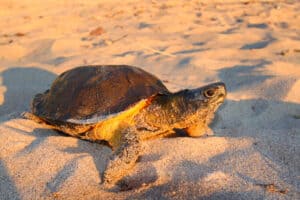
Their scientific name is Glyptemys insculpta.
Wood turtles have a slightly domed shell that flattens towards the edges. Their name is derived from the wood-like appearance of their shells. It has a rough structure with patterns that look precisely like grains of wood.
The upper part of their shells is brown, while the plastron is yellow and has dark patches towards the edges. The rest of the skin is yellow and sometimes orange with some dark spots. Wood turtles are, medium-sized with mature turtles achieving a length of between 5.5 and 8 inches.
While they are semi-aquatic, wood turtles never venture far from their habitat. These turtles are common in water bodies with a moderate flow and soft mud or sandy bottoms. When they venture out of the water, it is mostly in search of food. Being omnivores, they feed on vegetation, fruits, seeds, wild berries, insects, worms, and small aquatic animals.
Maturity in females takes about 18 years, while in males, it is about ten years. Nesting occurs between May and July. A female will lay between 3-20 eggs in a clutch and about two clutches each year. Incubation takes about 85-95 days.
The lifespan of wood turtles is between 45 and 55 years.
The turtles’ size and beauty have made them a target for the pet trade, contributing significantly to a decline in their numbers. In a bid to protect these turtles from extinction, Minnesota has outlawed owning a wood turtle. It is also illegal to adopt these turtles from the rest of the world. Should you spot one, you should report this to the authorities.
Wood turtles` are considered one of the most endangered species in Minnesota. They are found in the eastern edge bordering Wisconsin.
8. Western Painted Turtle
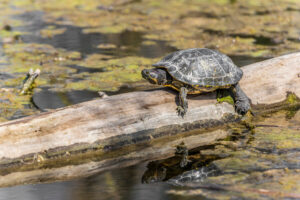
Chrysemys picta bellii, as this species is known in Latin,is one of the subspecies of painted turtles. The others are midland, southern and eastern turtles. The top shell is smooth and does not have ridges. It usually has a dark color, either olive or black. The skin and limbs are similar to the shell but with thin red, yellow or orange stripes.
Western painted turtles’ skin is usually orange.
An adult painted turtle measures between 4 and 10 inches but males are usually smaller than females. These turtles are aquatic, and they are common in areas with slow-moving water and little vegetation. They spend most of their time basking on the rocks next to a water body.
Western painted turtles are omnivores whose diet consists of algae, aquatic vegetation, crustaceans, insects, and small fish. In winter, these turtles hibernate by burrowing under the mud at the bottom of the water body.
Breeding in painted turtles occurs between May and September. A female turtle will lay between 5 and 15 eggs in a clutch, and up to 3 clutches in a year. The eggs will take between 70 and 90 days to hatch. It is worth noting that females can store sperms in their bodies for up to 3 years.
Sexual maturity in these turtles is achieved by the 9th year in males and 16th year in females.
Painted turtle pets cost between $20 and $50. They are not considered endangered species in Minnesota. The lifespan for this species is estimated between 30 and 50 years. They are suitable for beginner pet owners with little or no skills.
9. Midland Smooth Softshell
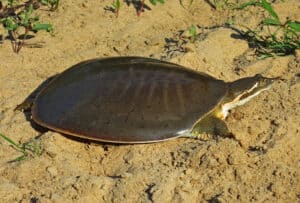
This smooth softshell, also known as Apalone mutica mutica, is one of the smooth aquatic turtles’ subspecies. Just like the spiny softshell, these turtles have a broad and flattened shell. The upper shell is plain and devoid of any bumps or keels. It is mainly olive with tiny black dots.
Their shells and limbs have the same color as the shell on the upper side, while the plastron is cream-colored or sometimes light grey. A distinguishing feature is a thin light stripe behind each eye. Mature females are bigger than males. Full-grown female turtles measure 6 to 14 inches, while males measure 4 to 7 inches.
Being aquatic, Midland smooth turtles spend most of their time in the water, only leaving to lay eggs. This species is common in moderately-flowing water bodies with lots of mud or sand at the bottom. They can be found in rivers, large oxbow lakes, streams, constructed reservoirs, and similar water bodies. These turtles are excellent swimmers, which acts as a defense against predators.
Midland smooth softshell turtles are carnivorous with a diet consisting of fish, crayfish, aquatic insects, crustaceans, snails, and frogs.
In midland turtles, breeding occurs between April and October. A mature female lays only one clutch each year containing 4-33 eggs between May and July. They will take about 60 to 80 days to hatch. Sexual maturity in males is achieved by the 4th year, while in females, it may take up to the 9th year.
The lifespan of a midland smooth softshell is between 30 and 40 years.
To take care of this softshell turtle, you will need to have excellent pet turtle skills. They can cause severe bites due to their long neck and strong jaws. You will thus need pet skills to take care of one. A midland pet turtle goes for about $40 to $60.
The main threat to their population is pollution and uncontrolled harvesting. However, they are generally not a threatened species.
10. Western Spiny Softshell
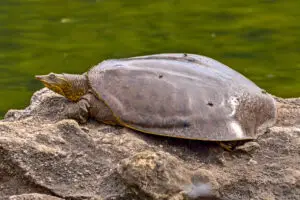
As the name suggests, western spiny softshell is another softshell subspecies. The scientific name for this turtle is Apalone spinifera hartwegi. They have a leathery, round, and slightly-domed shell with a small vertebral ridge. The shell color ranges from light to dark brown or olive with dark markings. Their plastron is cream-colored, while the skin and limbs have the same color as the carapace.
One of their distinguishable features is the thin snout-like mouth.
A mature female western spiny turtle has a length of up to 19 inches long while the males achieve only a maximum of 9 inches. As with most softshell turtles, these too have a long neck. It also has a thin light line behind each eye.
Western spiny softshell is common in moderate to fast-flowing rivers and streams with mud or sandy bottoms. These turtles use the muddy bottoms to bury themselves and ambush prey that swims near them. They spend most of their lifetime in the water and are excellent swimmers due to their webbed feet.
They are carnivorous, and their diet mainly consists of fish, crayfish, insects, and other small aquatic animals. These turtles have a lifespan of 20-50 years.
Breeding in western spiny softshell turtles occurs from May through July. A female turtle will lay one clutch each year with about 9 to 38 eggs. Sexual maturity in females occurs by the 8th year, while it may be achieved as early as the 4th year in males. Incubation takes between 60 to 90 days. Their main threats during this period include raccoons, river otters, and skunks.
A pet western spiny turtle costs between $70 and $280 and requires a sound understanding of pet turtles. Like other softshell turtles, their long neck allows them enough room to swing their head and bite. You need to be careful when handling these turtles.
11. Eastern Musk Turtle
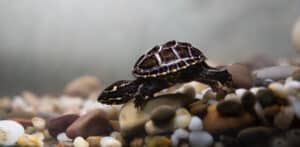
Eastern musk turtles are known by the scientific name Sternotherus odoratus. They are also referred to as common musk turtles. They are nicknamed “stinkpots” due to a powerful odor they secrete from their musk glands to ward off predators. It is one of the smallest turtle species in the world—a mature turtle measures between 2 and 4.5 inches.
The stinkpot has a black, grey, or brown carapace that is slightly domed and hinged towards the front part. The skin has the same color as the carapace but is a bit lighter. The plastron is usually brown, yellow, or yellowish-brown with two distinct yellowish-white lines behind the eyes.
Eastern musk turtles are found in the slow-flowing sections of large streams and rivers, swamps, ponds, and sloughs. They also prefer rocky banks as they spend most of the sunny days basking. Further, they may find shelter in dead vegetation and hollow tree trunks.
These turtles are omnivores but lean more towards meat than plants. Their diet comprises small amphibians, crustaceans, mollusks, algae, and other small aquatic animals. In Minnesota, they have only been found in Olmsted county.
Reproduction in musk turtles occurs between May and September. Female turtles lay eggs between May and July. She will lay up to two clutches in a year, each holding between 4 and 9 eggs. Eggs take between 75 and 95 days to hatch. Female musk turtles take up to 4 years to mature sexually, while the males take three years.
Due to their small numbers in Minnesota, the commercial business of musk turtles is highly controlled, and it might be pretty hard to get a pet musk turtle. You will also need previous pet skills to take care of these turtles.
How Can You Help Safeguard Turtle Populations in Minnesota?
From the above list, it is clear that some turtle species in Minnesota are considered endangered or threatened. Such turtles are at risk of becoming extinct. For this reason, the state of Minnesota has taken measures to prevent this and encourage growth in their populations.
While those measures are in place, they are not enough, and as such, your support is needed. These are some ways in which you can help:
Help Them Cross
Around May and June, turtles are usually active on the roads. Most of them end up being killed by motorists using the road. You can help by taking the turtles across in the direction they are headed in. You can also sensitize road users to be on the lookout for turtles on the road.
Avoid Disturbing Turtle Nests
While the idea might be very tempting, you are advised not to disturb a turtle nest when you stumble on one. Disturbing a nest may interfere with the incubation period or may harm the already hatched turtles. What you should do is alert other people of the turtle nest so that they may keep off.
Encourage A Natural Shoreline.
As noted above, some turtles prefer habitats that have natural vegetation. By encouraging the growth of natural shorelines, you will give these turtles a conducive environment to thrive. You can also lobby for individuals and companies to stop developments along the shorelines, which dramatically disturbs the turtle’s ecology.
Avoid Littering
Littering is a form of pollution, and this too affects the proper breeding of turtles. Littering attracts turtle predators such as raccoons, foxes, and skunks. These are especially dangerous to turtle eggs and hatchlings. Little may also get in the way of hatchlings when they are trying to get to the water. Plastic bags, for instance, can lead to suffocation if hatchlings get entangled in them.
Keep Storm Water Pollutants Free
Storm water ends up draining in turtle habitats. If it is polluted, it will destroy the turtle habitats, thus affecting them. The primary pollutants here are pesticides, lawn fertilizers, road salt, pet waste, among others. It is advisable that, whenever possible, you avoid using these contaminants. If that is not possible, ensure that these pollutants do not end up in turtle habitats.
Donate to Turtle Conservation Courses
Turtle conservation efforts require massive resources. You can help by contributing towards such courses both in monetary forms or human resources. Minnesota Zoo, for instance, needs lots of resources to research turtles. Such research will help understand turtles better and the ways to help them. As a turtle enthusiast, contributing to such courses will help safeguard turtle numbers.
Sensitizing Others
The greatest threat to the turtle population is human activities. A good number of people are indifferent when it comes to turtle conservation. Sensitizing such people on why we need to actively take care of turtle populations will go a long way in helping conserve their numbers. When people are aware of the dangers of their actions, they are likely to do better in the future.
Conclusion
In the above list, we have gone through 11 different turtle species found in Minnesota. Almost all of these are aquatic or semi-aquatic; some of them are endangered while others are threatened.
The state of Minnesota has taken measures like outlawing the purchase of those species. The greatest threat to most of these species is human activities in their habitat, which destroys their breeding grounds and destroys their eggs, and kills their hatchlings.
By taking part in the conservation measures, you will help safeguard turtles. Your actions may inspire others also to take part in the conservation efforts. Joining hands with people of goodwill double your conservations efforts. By educating yourself and others on turtles, you will better understand what you need to do to take care of them.